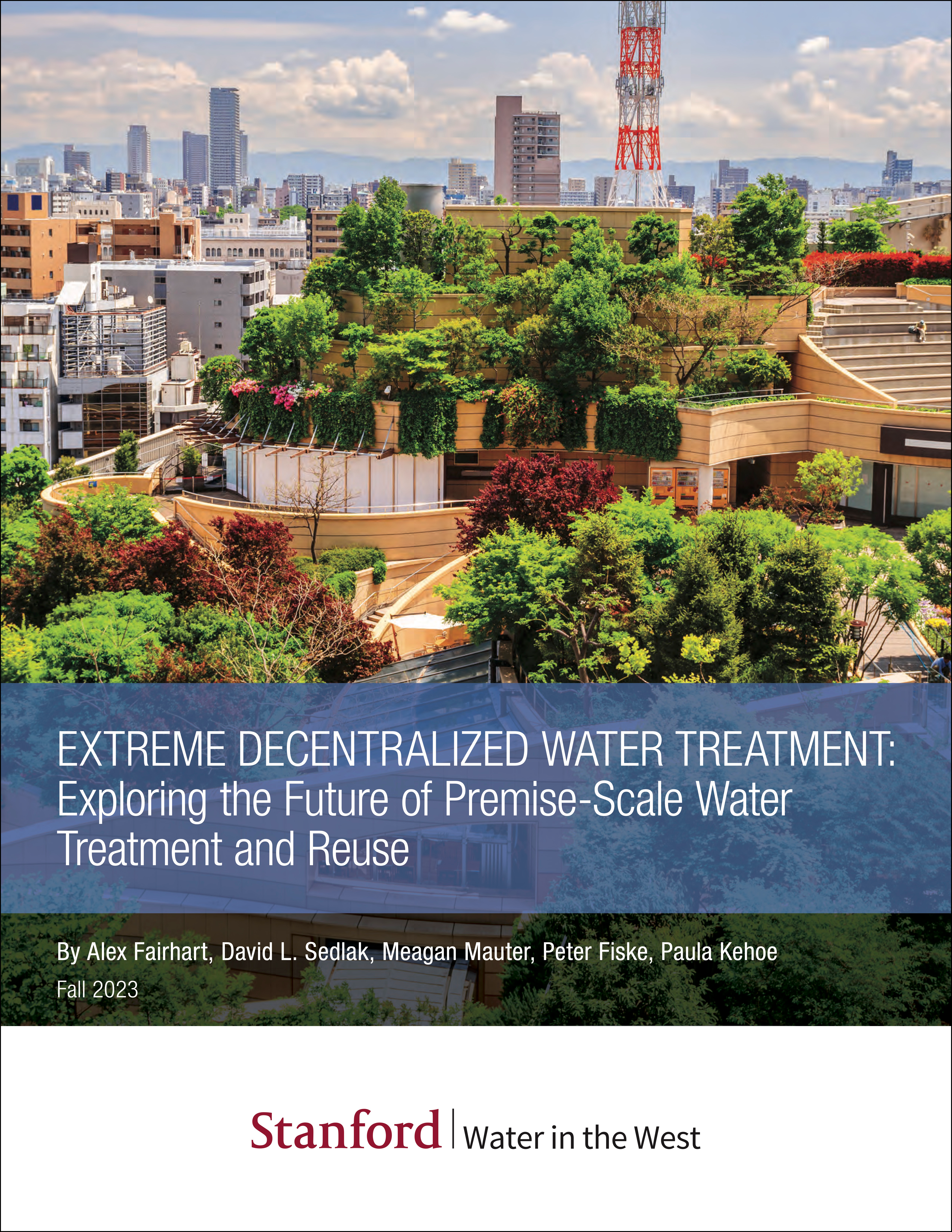December 07, 2023 | Water in the West | Insights
For most people, once water goes down the drain, it’s out of sight and out of mind. But if you were to follow the path of water from your shower, sink, or toilet, you’d likely wind through a maze of pipes, sloshing around with other wastewater until you arrive at a central treatment plant miles from your home. However, waning natural water supplies and new demands on piping infrastructure mean that these traditional systems are increasingly unreliable.
Recent technology innovations, policy changes, and market shifts are accelerating deployment of scaled-down water treatment solutions, but the market is still in its infancy. Scholars from Water in the West, a program of the Stanford Woods Institute for the Environment, and the National Alliance for Water Innovation organized a workshop with academics, water technology innovators, public health experts, environmental regulators, and venture capitalists to explore the future of extreme decentralization and its role in interfacing with and supporting traditional centralized systems. Experts from around the world produced a white paper outlining key insights and questions about effectively combining new and existing water treatment technology and barriers to progress.
Below, report coauthor Meagan Mauter, an associate professor of civil and environmental engineering at the Stanford Doerr School of Sustainability and School of Engineering, discusses how treating water across scales could make water systems more resilient and affordable.
What problems does a centralized approach to water treatment pose as we envision more sustainable water systems?
Mauter: Traditional water treatment plants have great economies of scale in terms of the cost and energy they take to operate. But there are also serious diseconomies of scale when it comes to water transport. It takes energy to pump water where it needs to go, and it can be expensive to build or maintain piping infrastructure. Expanding options for on-site reuse could help to minimize the infrastructure requirements and pumping costs for the entire system.
In the report, you talk about extreme decentralized water treatment. What does that look like?
Mauter: Decentralized water reuse refers to any treatment that diverts a portion of wastewater from reaching the centralized wastewater treatment facility, whether this happens at the scale of a neighborhood, a campus, or a building. In this report, we define extreme decentralization as any water reuse happening at the building scale or smaller. For example, you could envision using treated shower water to flush the toilet. Or you could even use a recirculating shower that treats the hot water flowing down the drain and recycles it back into the shower head.
The American West faces increasing pressure on its water supplies from climate change, prolonged drought, and increasing demand. How could a more decentralized approach contribute to long-term sustainability in this region?
Mauter: The reality is that natural supplies of water are dwindling. And the one truly consistent long-term, sustainable source of water is your wastewater. The question is just at what scale does it make sense to reuse that wastewater? The cost of alternative marginal supplies like seawater desalination are so high that on-site reuse even at very small scales starts to look financially attractive.
Where else would it make sense to expand on-site water treatment and reuse?
Mauter: This approach is also useful in places where you have high population density. For example, when you convert a block of single-family houses in New York into a 75-story apartment building, the flows of water and wastewater are much higher, and urban piping capacity may not be adequate. On-site reuse provides a less expensive alternative to digging up miles of city streets and expanding wastewater treatment facilities.
On-site reuse is also rapidly expanding in international settings where there is limited existing centralized wastewater treatment infrastructure. For instance, in India, some apartment building owners treat and sell wastewater for construction or other valuable uses.
Finally, we are seeing pretty rapid adoption in industry, where it can be challenging to secure permits and pay for connections to municipal systems. This benefits the wastewater facility, too – it’s much easier to treat concentrated industrial wastewater on-site before it has been diluted by rainwater or municipal sewage at a centralized facility.
If individuals and businesses started taking more advantage of on-site reuse, what would that mean for existing infrastructure?
Mauter: Incorporating on-site treatment and reuse doesn’t mean getting rid of centralized treatment facilities. It's really more about expanding the marginal capacity of those systems. We need tools to help municipalities understand what this means for the role and financial security of existing facilities and how decentralized systems can help with their mission of affordably securing water for their service area. Municipalities might start to provide incentive programs for decentralized reuse, much in the way they incentivize or mandate water-efficient appliances. New business models might emerge where municipalities operate building-scale reuse systems or service on-site treatment technology.
Are there lessons we can learn from other sectors that have taken a decentralized approach?
Mauter: We’ve seen huge movement toward hybrid systems in the energy sector where solar panels on your roof and batteries in your garage are working in concert with centralized generation and transmission systems to provide you and your neighbors with reliable power supply.
The other parallel is that demand on water and energy infrastructure systems can vary widely. This sets up an interesting planning problem: how much capacity do we need to maintain reliable supply? If you build too much, you pay tremendous capital and financing costs; if you build too little, you pay the social, political, and economic price of inadequate supply. We can often deploy decentralized systems more quickly, meaning that we could adaptively implement these technologies to more closely align with demand. On-site reuse could become a kind of “water peaking plant” during periods of intense water stress.
What kinds of progress do we need to make on-site water treatment more feasible for water users?
Mauter: Right now there’s a whole host of conflicting state-level regulations related to on-site reuse. At the local level, building codes and public health codes were simply not set up to support distributed water treatment and reuse – and they often contradict each other.
We need better scientific research on risk-based regulatory standards (e.g., how pure does your water need to be to safely flush a toilet or wash the laundry). Aligning regulatory standards across states will help manufacturers of on-site systems achieve economies of scale.
Some cost reductions will happen through “learning by doing” as manufacturers make and install more systems. But other capital cost reductions are harder to realize because of technology limitations. This is where research and development happening here at Stanford can help move the needle.
Mauter is also an associate professor in the Social Sciences Division at the Stanford Doerr School of Sustainability, a senior fellow at the Stanford Woods Institute for the Environment and the Precourt Institute for Energy, and research director of the National Alliance for Water Innovation (NAWI). The report was produced by scholars with the Water in the West program and NAWI. Coauthors of the paper include Alex Fairhart, David L. Sedlak, Peter Fiske, and Paula Kehoe.




![[Woods Logo]](/sites/default/files/logos/footer-logo-woods.png)
![[Bill Lane Center Logo]](/sites/default/files/logos/footer-logo-billlane.png)